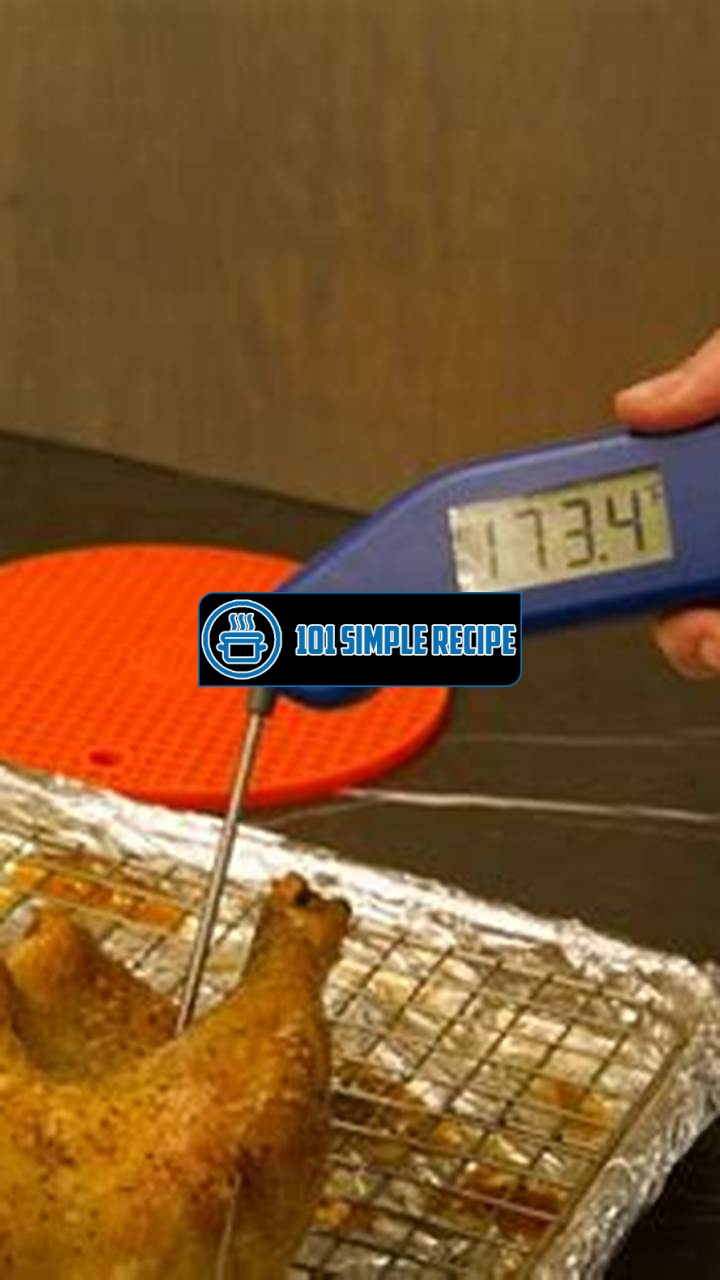Are you tired of overcooked or undercooked chicken? Knowing when chicken is done cooking is crucial to ensure it is safe to eat and has the perfect texture and flavor. But how do you know when it’s truly done? In this article, we will guide you through the different methods and indicators that will help you determine when your chicken is cooked to perfection. From checking the internal temperature to observing the color and texture, we’ve got you covered! So, let’s dive into the world of poultry cooking and discover the secrets to achieving juicy and succulent chicken every time. ️

Understanding Chicken Temperature when Done
Understanding the correct temperature for cooking chicken is essential to ensure that it is both safe to consume and delicious. By cooking chicken to the right temperature, you can be confident that all harmful bacteria have been killed, minimizing the risk of foodborne illnesses. Additionally, cooking chicken to the correct temperature helps to retain its juiciness and flavor. In this section, we will delve into the importance of knowing the right chicken temperature and how it impacts your cooking process.
Why Temperature Matters
Temperature plays a critical role in determining the doneness of chicken. Cooking chicken to the right internal temperature is crucial to ensure that it is safe to eat. The United States Department of Agriculture (USDA) recommends cooking chicken to an internal temperature of 165°F (74°C) to eliminate harmful bacteria such as Salmonella and Campylobacter. These bacteria can cause foodborne illnesses that lead to symptoms like diarrhea, abdominal cramps, and fever. By cooking chicken thoroughly, you can prevent the risks associated with these bacteria and protect yourself and your family.
Furthermore, cooking chicken to the right temperature ensures that it is tender, juicy, and flavorful. Overcooking chicken can result in dry and tough meat, which is far from appetizing. By using a thermometer to check the internal temperature, you can avoid undercooking or overcooking the chicken, achieving the ideal texture and taste.
The Different Types of Thermometers
There are various types of thermometers available that you can use to measure the internal temperature of chicken. The most common types include:
- Instant-read Thermometers: These thermometers provide quick and accurate readings in just a few seconds. They are inserted into the thickest part of the chicken and give an instant reading of the internal temperature.
- Dial Oven-safe Thermometers: These thermometers can be inserted into the chicken before it goes into the oven and remain in place throughout the cooking process. They have a dial that shows the temperature, allowing you to monitor the chicken’s progress.
- Probe Thermometers: These thermometers consist of a probe that is inserted into the chicken and connected to a digital display outside the oven. This allows you to monitor the temperature without opening the oven door, ensuring an accurate reading.
Each type of thermometer has its advantages and disadvantages. Choose the one that works best for you based on factors such as convenience, accuracy, and your cooking preferences.
Factors Affecting Chicken Temperature
Several factors can affect the temperature of chicken during the cooking process. It is important to consider these factors to ensure that the chicken reaches the desired internal temperature:
- Size of the Chicken: The size and thickness of the chicken will impact the cooking time and temperature. Larger and thicker pieces will require more time to cook thoroughly.
- Starting Temperature: The starting temperature of the chicken before cooking can influence the cooking time. Chicken that is taken directly from the refrigerator will take longer to reach the desired internal temperature compared to chicken that is at room temperature.
- Cooking Method: The cooking method used, such as baking, grilling, or frying, can affect the cooking time and temperature. Adjust the cooking time and temperature accordingly based on the method you choose.
- Stuffing: If you are cooking stuffed chicken, ensure that the stuffing reaches the recommended internal temperature as well. The stuffing inside can affect the overall cooking time and temperature.
By taking these factors into account and using a reliable thermometer to check the internal temperature, you can confidently ensure that your chicken is cooked thoroughly and safely.
Safe Minimum/Internal Temperatures
Discover the recommended minimum/internal temperatures that chicken should reach in order to be considered safe for consumption.
Whole Chickens
When cooking a whole chicken, it is crucial to ensure that it reaches the appropriate internal temperature to guarantee its safety. The recommended minimum/internal temperature for a whole chicken is 165°F (74°C). At this temperature, harmful bacteria such as salmonella and Campylobacter are effectively killed, making the chicken safe to eat.
It is important to measure the temperature at the thickest part of the chicken, which is typically the breast or thigh. Insert a food thermometer into these areas without touching the bone to get an accurate reading.
Note: Reaching the minimum/internal temperature is essential for eliminating the risk of foodborne illnesses associated with undercooked chicken. Consuming chicken that is not properly cooked can lead to severe health problems.
Chicken Breasts
Chicken breasts are a popular choice due to their lean meat. However, it is crucial to ensure that they are properly cooked to avoid any potential risks. The recommended minimum/internal temperature for chicken breasts is also 165°F (74°C).
When cooking chicken breasts, it is advisable to use a food thermometer to check the internal temperature. Overcooking can result in dry and tough meat, while undercooking can pose health risks.
Note: By following the recommended minimum/internal temperature, you can ensure that your chicken breasts are safe to eat while enjoying their tender and juicy texture.
Thighs and Drumsticks
Chicken thighs and drumsticks are known for their flavorful and juicy meat. To ensure their safety, they must also reach the recommended minimum/internal temperature of 165°F (74°C).
Due to the darker meat and higher fat content, thighs and drumsticks may take slightly longer to cook compared to chicken breasts. It is important to pay attention to the internal temperature to ensure that they are cooked thoroughly.
Note: To avoid any unpleasant illnesses or infections, make sure that the thighs and drumsticks are no longer pink and reach the recommended internal temperature. This will guarantee both safety and deliciousness.
In conclusion, it is crucial to cook chicken to the appropriate minimum/internal temperatures to ensure its safety for consumption. Whether cooking a whole chicken or specific cuts like breasts, thighs, or drumsticks, reaching a minimum/internal temperature of 165°F (74°C) is essential. By using a food thermometer to check the temperature, you can enjoy delicious, tender, and safely cooked chicken.
Methods for Checking Chicken Temperature
When cooking chicken, it is crucial to ensure that it is thoroughly cooked to eliminate any risks of foodborne illnesses. There are several methods you can use to check the temperature of chicken and guarantee it is cooked to perfection.
Using a Meat Thermometer
One of the most accurate and reliable ways to determine if chicken is done cooking is by using a meat thermometer. This handy kitchen tool allows you to measure the internal temperature of the chicken, ensuring it reaches the safe minimum temperature for consumption.
To use a meat thermometer, insert the probe into the thickest part of the chicken, avoiding contact with the bone. Wait for a few seconds until the reading stabilizes, and then remove the thermometer to check the temperature. The chicken is considered done when it reaches an internal temperature of 165°F (74°C), which ensures that any harmful bacteria are killed.
Important Note: Always remember to clean and sanitize your meat thermometer after each use to prevent cross-contamination.
The Finger Test
If you don’t have a meat thermometer on hand, you can rely on the finger test to gauge the doneness of chicken. This simple method involves touching the chicken with your fingers and assessing its firmness.
Begin by pressing the chicken with your finger. If it feels soft and squishy, it is not done and needs more time to cook. As the chicken cooks, it will gradually firm up. When it feels firm but still slightly yielding, it is cooked to perfection. Avoid applying excessive pressure as it may result in dry chicken.
Pro Tip: Remember to wash your hands thoroughly before and after using the finger test to maintain good hygiene practices.
Appearance and Juiciness
In addition to using a meat thermometer or the finger test, you can also rely on visual cues to determine if the chicken is ready to be savored. Cooked chicken should have a golden-brown exterior with no signs of pink or rawness. Make sure to cut into the thickest part of the chicken and check that the juices run clear. If there is any pinkness or redness, the chicken needs more time on the heat.
Furthermore, the chicken should be juicy and moist. Dry chicken indicates overcooking, while overly pink and bloody chicken suggests undercooking. Achieving the perfect balance of appearance and juiciness will make your chicken a delectable delight.
Fun Fact: The Maillard reaction is responsible for the golden-brown crust that forms on the surface of cooked meat, adding delicious flavor.
Common Mistakes to Avoid
When it comes to cooking chicken, determining the right temperature can be a challenge. Many people make common mistakes that can lead to undercooked or overcooked chicken. To ensure that your chicken is perfectly cooked every time, it is important to avoid these common pitfalls.
Reliance on Cooking Time
One of the most common mistakes people make when cooking chicken is relying solely on cooking time as a measure of doneness. While cooking time can provide a general guideline, it is not always accurate. In fact, the cooking time can vary depending on factors such as the size of the chicken, the type of oven used, and even the altitude of your location. Instead of relying solely on cooking time, it is crucial to use a meat thermometer to check the internal temperature of the chicken.
Common Mistake: Assuming the chicken is done based on cooking time alone.
By using a meat thermometer, you can ensure that the chicken reaches the appropriate temperature and is safe to eat. The internal temperature of chicken should reach 165°F (75°C) to be considered fully cooked. Insert the thermometer into the thickest part of the chicken, avoiding any bones, to get an accurate reading.
Not Allowing for Carryover Cooking
Another mistake to avoid is not allowing for carryover cooking. Carryover cooking refers to the increase in temperature that occurs after the chicken is removed from the heat source. Many people make the error of thinking that the chicken is not done cooking because it does not reach the desired temperature while still in the oven or on the stovetop. However, the residual heat will continue to cook the chicken even after it is taken out of the oven or off the heat source.
Common Mistake: Taking the chicken out of the oven or off the heat source too early because it hasn’t reached the desired temperature.
To account for carryover cooking, it is recommended to remove the chicken from the heat source when it is slightly below the target temperature. Cover the chicken with foil and allow it to rest for a few minutes. During this resting period, the temperature will continue to rise, and the chicken will reach the desired doneness.
Skipping the Resting Period
The resting period is a crucial step that should not be skipped when cooking chicken. After the chicken has been cooked, it needs a few minutes to rest before being served. This allows the juices to redistribute throughout the meat, resulting in a more flavorful and moist chicken.
Common Mistake: Cutting into the chicken immediately after cooking, without allowing it to rest.
During the resting period, tent the cooked chicken with foil to help retain its warmth. This will also prevent the chicken from drying out as it sits. The general rule of thumb is to let the chicken rest for about 5-10 minutes before slicing or serving.
By avoiding these common mistakes, you can ensure that your chicken is cooked to perfection. Remember to use a meat thermometer, account for carryover cooking, and allow the chicken to rest. With these tips in mind, you can confidently cook chicken to the correct temperature and enjoy a delicious meal every time.
Recipes and Cooking Tips
When it comes to cooking chicken, achieving the perfect temperature is crucial to ensure it is safe to eat and retains its delicious taste. In this article, we will explore a selection of mouthwatering recipes and provide you with some useful cooking tips to help you achieve that ideal chicken temperature every time.
Grilled Lemon-Pepper Chicken
If you’re a fan of grilled chicken, then this recipe is for you. The combination of tangy lemon and zesty pepper creates a flavorful marinade that takes your grilled chicken to the next level. To ensure your chicken is perfectly cooked, it is essential to monitor the internal temperature using a meat thermometer. Cooking your chicken until it reaches an internal temperature of 165°F (74°C) will guarantee it is safe to consume.
Pro tip: Before grilling, let the chicken marinate in the lemon-pepper mixture for at least 30 minutes to allow the flavors to penetrate the meat.
Oven-Baked Honey Mustard Chicken
If you prefer the convenience of oven-baked chicken, this recipe will not disappoint. The sweet and tangy flavors of honey mustard create a tantalizing glaze that adds a burst of flavor to your chicken. To ensure your chicken is cooked to perfection, it is crucial to reach the recommended internal temperature of 165°F (74°C). This will guarantee that your chicken is both safe to eat and moist on the inside.
Pro tip: Baste your chicken with the honey mustard glaze every 10-15 minutes while it bakes to enhance the flavors and keep the meat tender and juicy.
Expert Tips for Moist and Tender Chicken
Aside from following specific recipe instructions, there are expert tips you can utilize to ensure your chicken turns out moist and tender every time. Here are a few key pointers:
- Brine your chicken: Soaking your chicken in a mixture of salt, water, and other flavorings before cooking can help retain moisture and enhance its flavor. Brining can be especially useful when cooking lean cuts of chicken.
- Let it rest: After cooking your chicken, allow it to rest for a few minutes before cutting into it. This helps the juices redistribute throughout the meat, resulting in a moister and more flavorful chicken.
- Use a meat thermometer: Investing in a reliable meat thermometer is essential for determining the doneness of your chicken accurately. This takes the guesswork out of cooking and ensures your chicken is fully cooked without overdoing it.
- Avoid overcrowding the pan: When pan-frying or sautéing chicken, make sure not to overcrowd the pan. Overcrowding can lead to uneven cooking and steaming instead of browning. Cook your chicken in batches if necessary.
- Marinate for flavor: Marinating your chicken not only adds flavor but can also help tenderize the meat. Acidic marinades, like those with lemon juice or vinegar, can break down proteins and make your chicken more tender.
Expert tip: Remember, the most reliable way to determine if your chicken is done is by checking its internal temperature with a meat thermometer. It’s worth investing in this kitchen essential to ensure perfect results every time.
In conclusion, knowing when your chicken is done cooking is crucial for both food safety and culinary satisfaction. By following these delicious recipes and helpful cooking tips, you’ll be able to achieve the perfect chicken temperature every time. So go ahead and enjoy your mouthwatering chicken dishes with confidence!
Thank you for taking the time to read our article on chicken temp when done. We hope that you found the information helpful and informative. If you have any further questions or need more clarification, please don’t hesitate to reach out to us. We are always here to help!
Frequently Asked Questions
Here are some frequently asked questions about chicken temp when done:
| No. | Questions | Answers |
|---|---|---|
| 1. | What is the recommended internal temperature for cooked chicken? | The recommended internal temperature for cooked chicken is 165°F (74°C). This ensures that any harmful bacteria present in the chicken are killed, making it safe to consume. |
| 2. | How long should I let the chicken rest after cooking? | It is recommended to let the chicken rest for about 5-10 minutes after cooking. This allows the juices to redistribute throughout the meat, resulting in a more flavorful and tender final product. |
| 3. | What are some safe methods to check the temperature of cooked chicken? | There are a few safe methods to check the temperature of cooked chicken. You can use a meat thermometer inserted into the thickest part of the meat, making sure not to touch the bone. Alternatively, you can cut into the chicken and check that the juices run clear and there is no pinkness in the center. |
| 4. | Can I eat slightly pink chicken? | No, it is not safe to eat slightly pink chicken. Chicken should be cooked until it reaches an internal temperature of 165°F (74°C) to ensure that any harmful bacteria are destroyed. Consuming undercooked chicken can lead to foodborne illnesses. |
| 5. | What should I do if I accidentally overcook the chicken? | If you accidentally overcook the chicken and it becomes dry, you can try adding some sauce or gravy to moisten it. Another option is to use the overcooked chicken in dishes where it will be mixed with other ingredients, such as a chicken salad or stir-fry. |
| 6. | Is it safe to partially cook chicken and then finish cooking it later? | No, it is not safe to partially cook chicken and then finish cooking it later. Partially cooked chicken can harbor harmful bacteria, which can multiply and cause foodborne illnesses if not cooked to the recommended internal temperature in one continuous cooking process. |
Come Back Soon!
We hope you found this article on chicken temp when done informative and helpful. If you have any more questions or need further guidance, feel free to visit our website again in the future. Our team is continuously updating and adding new content to provide you with the latest information. Thank you for reading and see you soon!
Jump to Recipe
Chicken Temp When Done

Learn about the recommended internal temperature for cooked chicken and other important tips.
- 4 chicken breasts
- 1 tbsp olive oil
- 1 tsp salt
- 1 tsp pepper
- Preheat the oven to 425°F (220°C).
- Rub the chicken breasts with olive oil, salt, and pepper.
- Place the seasoned chicken breasts on a baking sheet and cook in the preheated oven for 25-30 minutes until the internal temperature reaches 165°F (74°C).
- Remove the chicken from the oven and let it rest for 5 minutes before serving.






